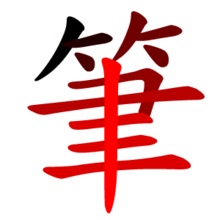 Japanese
Hiragana Katakana Kanji Japanese
Hiragana Katakana Kanji
Japanese language learning
information including:
Hiragana -
pronunciation and writing
Katakana -
pronunciation and writing
Kanji - grades 1-6
(教育漢字 Kyōiku kanji)
Vocabulary -
nouns, verbs, adverbs, and adjectives |
|
|
|
|
| |
 Writing
Japanese Writing
Japanese
The Japanese writing system can take awhile to learn but it can also
be a lot of fun. If you're a beginner, you'll need to learn romaji
before taking on Japanese hiragana and katakana scripts or kanji. You'll probably find
that learning kanji can be pretty addicting. The characters
represent things found in nature and abstract concepts. As you
continue to study them, you'll eventually see patterns
and want to learn as many as you can. The following is an
explanation of the four ways to write Japanese including a complete
list of kyouiku kanji, which are the kanji learned through grade 6
of elementary school in Japan.
A single sound in Japanese can be
written in any of the following four ways but each sound can only be pronounced one way. |
|
|
 Romaji Romaji
This script uses English letters to represent Japanese
sounds and words and is a substitute script used until hiragana,
katakana, and kanji are learned. It was devised as a way to
communicate in spoken and written Japanese quickly without needing
to learn the thousands of combined characters in the other scripts. Romaji is used in Japanese, especially for company
names and logos, advertising, and when inputting Japanese into a
computer. Romaji is used anywhere in Japan where there are many
foreigners, such as big cities, train stations, and hotels. Romaji
is the first script you should learn. |
 Hiragana Hiragana
This is a Japanese script used for already
established words in the language such as sun, moon, house,
mountain, people, etc. This script, along with kanji, make up about
98% of the language. This is the second script you should learn. |
 Katakana Katakana
This is a Japanese script used for foreign or
borrowed words from other languages. Words such as convenience store
(combini), television (terebi), and hotel (hoteru), are all written
in katakana. This script makes up about 2% of the language. The
usage is growing as more words are incorporated into Japanese from
other languages. This is the third script you should learn. |
|
 Kanji Kanji
These are Chinese characters which were brought into the Japanese
language thousands of years ago. The characters represent things in
nature and are really fun to learn. This is the fourth script you
should learn. |
 Kanji writing order Kanji writing order
Kanji writing order, typically referred to as stroke
order, refers to the correct order in which Chineses character are
written. |
 Kanji - Grade 1 Kanji - Grade 1
The 80 kanji characters Japanese elementary school students
learn in 1st grade. |
 Kanji - Grade 2 Kanji - Grade 2
The 160 kanji characters Japanese elementary school students
learn in 2nd grade. |
 Kanji - Grade 3 Kanji - Grade 3
The 200 kanji characters Japanese elementary school students
learn in 3rd grade. |
 Kanji - Grade 4 Kanji - Grade 4
The 200 kanji characters Japanese elementary school students
learn in 4th grade. |
 Kanji - Grade 5 Kanji - Grade 5
The 185 kanji characters Japanese elementary school students
learn in 5th grade. |
 Kanji - Grade 6 Kanji - Grade 6
The 181 kanji characters Japanese elementary school students
learn in 6th grade. |
|
|
Representing Sounds |
|
The following shows the only way the sound
ki can be written in romaji, hiragana, and
katakana, and one of the many ways ki can be written in kanji. |
|
Romaji |
Hiragana |
Katakana |
kanji |
ki |
 |
 |
 |
|
The sound ki can be written
with many different kanji. Keep in mind most kanji have two
or more pronunciations....The Chinese pronunciation known as
onyomi, and the Japanese pronunciation known as
kunyomi.
The onyomi (音読み), Chinese reading, is a Japanese approximation of
the Chinese pronunciation of the character at the time it was
introduced. Some kanji were introduced from different parts of China
at different times, and so have multiple onyomi, and often multiple
meanings.
The kunyomi (訓読み), Japanese reading, or native reading, is a reading
based on the pronunciation of a native Japanese word that closely
approximated the meaning of the Chinese character when it was
introduced. As with onyomi, there can be multiple kunyomi readings
for the same kanji, and some kanji have no kunyomi at all.
The following are examples of ten kanji that have the sound
ki. |
|
|
Kanji |
Sounds in onyomi |
Sounds in kunyomi |
Meanings |
 |
moku, boku |
ki |
tree
wood |
 |
ki, ke |
iki |
spirit
air |
 |
ki |
shiru-su |
record
write down |
 |
ou |
ki |
yellow |
 |
ki |
kae-ru |
return |
 |
ki |
no kunyomi for
this kanji |
steam |
 |
ki |
no kunyomi for
this kanji |
period of time |
 |
ki |
o-kiru |
awaken |
 |
ki |
yoroko-bu |
rejoice |
 |
ki |
utsuwa |
container |
|
|
|
 Japanese
Hiragana Katakana Kanji
Japanese
Hiragana Katakana Kanji






















